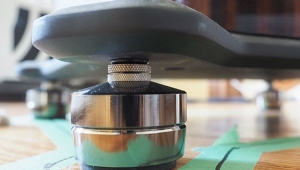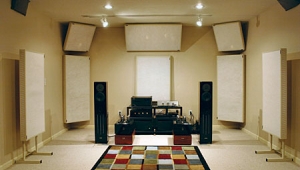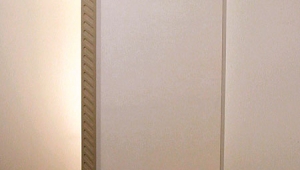| Columns Retired Columns & Blogs |
Rives Audio PARC 3-Band Parametric Equalizer Measurements
Sidebar 3: Measurements
Unusually, the Rives PARC has a hardwired bypass: when the unit is turned off, it passes the input signal to the output jacks. Turned on, the PARC had unity gain at 1kHz both when its Bypass LED was lit, and when the equalization was engaged but set to do nothing. It will not, therefore, mess up its owner's system-gain architecture. The PARC didn't invert signal polarity, and its input impedance was high 104k ohms unbalanced but a much lower 10.2k ohms balanced (both figures measured at 1kHz). The output impedance was a usefully low 25 ohms from the single-ended RCA jacks, double that from the balanced XLRs.
The Frequency, Q, and Attenuation controls were accurately calibrated, the measured parameters matching the displayed information. Fig.1, for example, shows the individual responses of the three filters for each channel that had been decided on for Kalman Rubinson's auditioning. (Note that these parametric filters provide notches at the selected frequencies, not peaks.) The lower two traces in fig.2 show the combined effect of these notch filters, compared with the response in powered Bypass. For the record, the latter offers very slightly more ultrasonic extension above 100kHz, but that won't be an issue for humans. Crosstalk in both directions for both unbalanced and balanced (not shown) operation was buried below the noise floor, which itself was very low. (I couldn't replicate the noise problems with the balanced output that Kal experienced.)
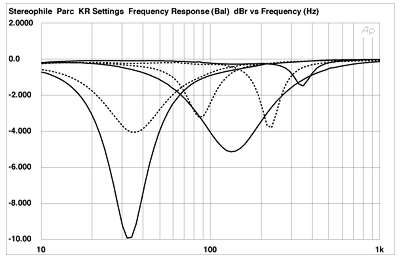
Fig.1 Rives PARC, frequency response of each of the three parametric filters as set for KR's auditioning (2dB/vertical div., right channel dashed).
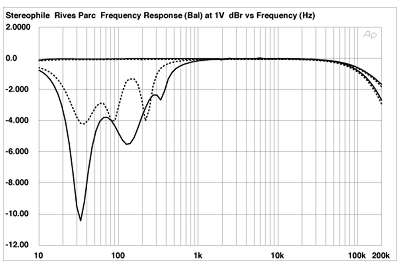
Fig.2 Rives PARC, frequency response in bypass mode (top at 100Hz and 100kHz) and as set for KR's auditioning (2dB/vertical div., right channel dashed).
All the distortion measurements were taken with the three parametric filters in-circuit but with the attenuation of each set to 0dB. I could not drive the PARC into overload in balanced mode, even at my Audio Precision System One's maximum output of 15V. In unbalanced mode, the unit hard-clipped at 5V RMS input/output (fig.3)—well above the level required to drive any amplifier used into overload. The downward slope of the trace in fig.3 below the onset of distortion indicates that what distortion components do exist in the PARC's output lie below the noise floor at all levels. The distortion percentages plotted in fig.4, taken at 1V output into 100k ohms and 600 ohms in both balanced and unbalanced modes, are therefore dominated by noise. Interestingly, the unbalanced output has half the THD+noise compared with the balanced, but the right channel is even better in this respect. (This may have had something to do with the system grounding I used.)
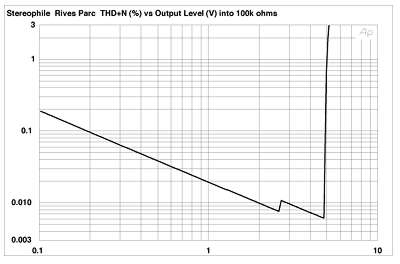
Fig.3 Rives PARC, unbalanced, distortion (%) vs output voltage at 1kHz into 100k ohms, EQ set to 0dB attenuation.

Fig.4 Rives PARC, THD+N (%) vs frequency (from bottom to top): 1V into 100k and 600 ohms, balanced; 1V into 100k and 600 ohms, unbalanced, EQ set to 0dB attenuation.
To further examine the PARC's linearity, fig.5 shows an FFT-based spectrum of the unit's unbalanced output driving a 1kHz tone at 1V into 8k ohms, with 32 spectra averaged to drop the noise floor. The only distortion harmonics visible are the second, third, and fourth, but as none of these rises above -110dB, they are essentially nonexistent. The small spikes at the far left of this graph are due to spuriae at the full-wave-rectified power-supply frequency of 120Hz and its harmonics. I could not eliminate these, no matter how I arranged the grounding between the PARC and my PC-based analyzer. This noise was a little higher in balanced mode, but was still negligible by any meaningful measure.

Fig.5 Rives PARC, spectrum of 1kHz sinewave, DC-10kHz, at 1V into 8k ohms, EQ set to 0dB attenuation (linear frequency scale).
Finally, fig.6 shows a similar spectrum taken with the PARC driving an equal mix of 19kHz and 20kHz tones at 1V into 8k ohms. (Each of the individual components lies at -6dB with respect to the level of the summed signal.) The difference tone at 1kHz is the highest in level, but at -80dB (0.01%) is low enough to be of no concern.
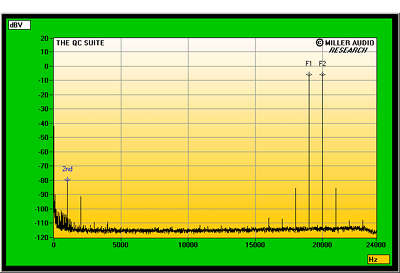
Fig.6 Rives PARC, HF intermodulation spectrum, DC-24kHz, 19+20kHz at 1V into 8k ohms, EQ set to 0dB attenuation (linear frequency scale).
Befitting its pro-audio lineage, Rives' PARC appears to be bombproof. Its settings are accurately calibrated, and its excellent technical performance conforms to the First Law of Outboard Processors: "First, do no harm to the signal."—John Atkinson
- Log in or register to post comments
